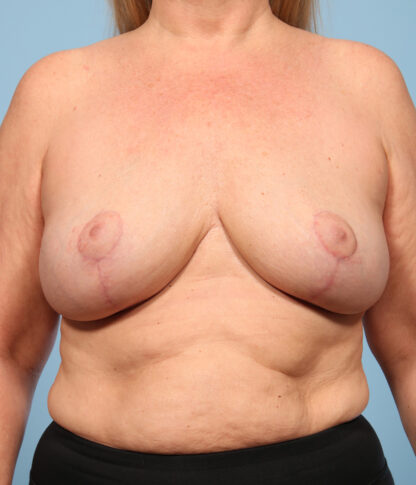Breast Lift
Many women struggle with excessive breast skin but not enough volume, resulting in the appearance of sagging breasts. With cosmetic plastic surgery procedures like a breast lift, also known as mastopexy, patients can restore a more youthful appearance by elevating the breasts and nipples. Sometimes combined with breast augmentation, the procedure can utilize a variety of techniques to achieve a revitalized look.
The effectiveness of mastopexy is demonstrated by its popularity. Twenty years ago, about 50,000 breast lifts were performed annually in the United States. Now, about 150,000 are performed every year. Patients and plastic surgeons alike have discovered that a breast lift is a safe and effective way to achieve their desired breast size and shape.
At Aesthetic Plastic Surgery, our board-certified plastic surgeon, Gene Sloan, MD, is committed to helping patients look and feel their best. His experience and skill with advanced breast lift techniques, as well as with breast augmentation and other breast enhancement options, allow him to develop customized treatment plans that can successfully address individual patient needs and goals.
Explore Topics On This Page
What Is the Anatomy of Sagging Breasts?
The medical term for sagging breasts is mammary ptosis. In the sagging breast, there is too much skin for the amount of volume. Not only does the skin cover a larger area, but it is thinner and less elastic. The skin is also weaker and is unable to support the weight of the breast. In these cases, the breast skin will often show stretch marks (stria), which are tears in the deeper layer of the skin (dermis). Within the breast, the tissue has become more mobile and less cohesive, and the supporting ligaments of the breast are stretched. The nipple and breast tissue sit below the breast crease, causing upper breast flatness and lower breast skin to lie on the lower chest.
As a result of these internal and skin surface dynamics, the appearance of the breast is changed. The nipple and much of the breast gland hang over the inframammary fold. With this redistribution of volume, the upper portion of the breast becomes flattened. The nipple sits low on the breast and is a longer distance from the landmarks of the upper chest, such as the collarbone. Additionally, just under the breast there is increased contact between the breast skin and the chest wall skin, which can often cause rashes and irritation.
Who Is a Candidate for Breast Lift Surgery?
There are several reasons why women develop sagging breasts. The condition can occur due to the natural aging process, pregnancy, breastfeeding, menopause, and other factors. When breasts begin to droop (ptosis), the nipples will also typically sit below the inframammary fold and point downwards. Candidates for a breast lift will often experience sagging breasts and nipples at varying degrees, such as:
- Minor Ptosis – Nipple is at the level of the inframammary fold
- Moderate Ptosis – Nipple is between the level of the inframammary fold and the lowest point of the breast
- Major Ptosis – Nipple at the bottom of breast is pointing downward and most of the breast tissue is below the inframammary crease
- Glandular Ptosis – Nipple is above the fold and some of the gland is below the fold
- Pseudoptosis – Nipple is above the fold and there is very little volume left, most of which sits below fold
It is also important to note that some patients may not be ideal candidates for a breast lift. Dr. Sloan will not typically recommend the procedure for patients whose natural breasts sit low on the chest wall, and he will not perform the surgery on patients who are unable to quit smoking before and after the procedure.
What Are the Different Breast Lift Techniques?
The only way to accomplish a breast lift is through surgery. Breast lift techniques involve the removal of skin, placing an implant, or both. The procedure almost always involves raising the nipple and reducing the size of the areola. During the consultation process, Dr. Sloan will determine how much excess skin needs to be removed and how much volume, if any, needs to be taken away or added.
There are multiple breast lift incision options, and which of those is ultimately utilized will depend on a patient’s individual needs, goals, and anatomy. An important concept to understand is that the greater the lift required, the more skin needs to be removed and the longer the scar. Some scarring is to be expected, but Dr. Sloan takes great care to minimize visible scars. Common breast lift techniques include:
- Crescent – Incision is made above the nipple where a crescent of skin is removed, and the nipple is raised 1 to 2 cm.
- Periareolar – Incision is made around the areola, the surrounded sagging skin is removed, and the nipple is raised slightly. This is typically used with an implant for correction of a tuberous breast.
- Vertical (lollipop)– Incision is made around the areola then vertically down the underside of the breast to the natural crease.
- Anchor – Incision is made around the areola, down the breast, and along the breast crease. This removes the most skin and achieves the greatest lift.
Can Breast Lift Surgery Be Combined with Breast Implants?
Many women seek to combine their mastopexy with breast implants to achieve their desired appearance. In situations where only minor lifting is required, Dr. Sloan finds it acceptable to perform the procedures at the same time. For patients with moderate to major ptosis of the breast, he strongly believes that it is better to perform the mastopexy first, then perform a breast augmentation three or more months later. This is particularly true for greater amounts of sagging or situations where a significant amount of breast tissue needs to be removed and replaced with an implant in order to create a more rounded appearance.
Some potentially beneficial reasons to undergo two-stage breast augmentation and lift include:
- Less risk of bottoming out of the implant.
- Allows for better muscle coverage at the second-stage breast augmentation.
- Reduces the risk of unplanned secondary operations.
- Decreases the complication rate.
A simplified way to determine whether or not an implant would be recommended is as follows: If a woman wants her breasts to be lifted and smaller or the same size, typically just a lift is required. If she requires to be lifted and larger, then an implant and lift would be recommended. If she wants to be lifted and have a lot of upper pole fullness, then frequently a lift with tissue reduction followed by an implant is recommended.
To learn more about pursuing both procedures in conjunction with each other, we recommend scheduling a consultation with Dr. Sloan to discuss any concerns and questions you may have.
What Else Can Be Done to Improve the Results of a Mastopexy?
In some instances, GalaFlex® mesh is used to help support the breast tissue. This is a synthetic mesh that mimics a naturally occurring substance in the body. It is often described as an “internal bra.” The GalaFlex® gradually breaks down as it is replaced by the patient’s own collagen. This process takes about two years. The use of GalaFlex® mesh in the breast is considered an off-label use by the FDA, but it is widely used in cosmetic and reconstructive plastic surgery of the breast.
How Can Abnormally Shaped Breasts Be Treated?
Constricted Breast
A common abnormal breast shape is the constricted breast. In this condition, the inframammary fold is higher than normal and somewhat tight. It may also be straighter across rather than curved. Oftentimes, there is deficient breast volume in the lower part of the breast and a very short distance from the nipple to the inframammary fold. Typically, a breast implant is used, the nipple may be moved, and manipulation of the internal surface of the glandular tissue may be required to get the implant to sit in the pocket appropriately.
Tuberous Breast
A more severe variant of the constricted breast is the tuberous breast. In this situation, the inframammary fold is higher and tighter, and the distance from the fold to the nipple is reduced. The areola is usually wider than normal and most of the glandular tissue is concentrated around the areola, creating a narrow breast and wide space between the two. The tuberous breast may consist mostly of fat or mostly of glandular tissue. The condition may be mild or severe with a small or large amount of breast tissue.
Tuberous breasts are treated by lowering the inframammary fold, reducing the areola size, and manipulating the internal glandular tissue. Since many patients with tuberous breasts find it to be an unattractive shape and the breasts are usually smaller than desired, an implant is often used to create a larger breast; therefore, a more attractive shape is given.
How Is Recovery and Healing After a Breast Lift?
Mastopexy is performed as an outpatient procedure under general anesthesia. The procedure typically lasts one to three hours. After one or two hours in the recovery room, patients can usually return home, where they are instructed to relax, but bed rest is not necessary. In fact, Dr. Sloan suggests that patients move around some and can shower the same day or the next, as very little wound care is needed.
The initial dressing is usually a clear plastic dressing over the nipple and brown paper tape over the vertical and horizontal incisions. A week after surgery, the clear plastic dressing and sutures around the nipple are removed. The areola is then covered with tape. The brown paper tape is changed every two weeks, initially by our staff and then by the patient. For patients who are sensitive to paper tape, silicone strips, tape, or cream can be substituted. Scar treatment is recommended for a full three months to achieve the best results.
A loose-fitting bra is usually worn for the first two weeks so as not to compress the nipple area and compromise circulation. After that, a sports bra or other comfortable bra may be worn. It usually takes three months to see the final result from a mastopexy.
Pain after breast lift surgery is typically very moderate. Oftentimes, non-narcotic analgesics are all that’s required. This allows for a faster recovery and reduces the side effects that are often seen with medications such as Demerol and codeine.
What Results Can I Expect After Breast Lift Surgery?
Early after surgery, the breast skin will be tight. The upper portion of the breast will be full and perhaps rounded, and the bottom portion of the breast will be flattened. This shape is temporary and as time goes on, the upper portion will flatten and the bottom portion should fill out, creating a more desirable shape. Unfortunately, the skin may continue to stretch and the breast may continue to sag beyond this desired endpoint; however, it will not return to the original position and shape that it started from before surgery.
Tightening the breast skin forces the tissue into a smaller volume. It becomes denser and this firmness is due to the external compression by the skin instead of a gain of internal cohesiveness by the breast tissue. Since the skin is weak to begin with, the early tightness is only temporary. If an implant is used, the resulting tightness of the breast will depend on how much of the final breast comes from natural tissue and how much comes from the implant.
How Much Does Breast Lift Surgery Cost?
The cost of breast lift surgery can vary depending on factors such as the complexity of the procedure, facility fees, anesthesia, and more. It is important to remember that this is an individualized surgery tailored to your unique anatomy and aesthetic goals, which can influence the final cost. Our team will provide you with a customized estimate following your consultation.
At Aesthetic Plastic Surgery, we also offer financing options for qualified applicants. Through our partnership with reputable third-party lenders, patients have access to flexible plans that can help make payments more manageable.
Additional Breast Lift Frequently Asked Questions
Can a breast lift affect future pregnancy and breastfeeding?
Mastopexy will not interfere with pregnancy, but you should expect it to interfere with breastfeeding. If you are planning a pregnancy, your breast skin may stretch and offset the results of mastopexy.
What type of scarring can be expected following a breast lift?
While all surgery leaves scars, some may be more visible than others. Although good wound healing after a surgical procedure is expected, abnormal scars may occur within the skin and deeper tissues. There is the possibility of visible marks in the skin from sutures. In some cases, scars may require surgical revision or treatment. Poor scarring is to be expected in the presence of nicotine use by any method. Conditions such as diabetes or hypertension, as well as some medications, may interfere with wound healing.
What are the risks of breast lift surgery?
Risks of mastopexy fall into three categories: limitations, trade-offs, and complications.
- Limitations – With current technology, there is no way to lift the breast without creating scars. The more breast skin that is removed, the longer the scars will be. A breast lift does not remove stretch marks that occur outside of the area of skin that is removed. The breast will continue to sag with age, and some women have a normal-shaped breast that is positioned low on to the chest wall. There is not a current method that predictably and consistently elevates the position of the entire breast to a significant degree.
- Trade-offs – There is also not a predictable and long-lasting way to achieve upper breast fullness without an implant. Additionally, one should expect a higher incidence of interference with nursing and nipple sensation with a breast lift.
- Complications – Some patients may experience a change in the sensitivity of the nipples and the skin, as well as potential excessive firmness of the breast. Wound disruption or delayed healing is possible.
Patients should have realistic expectations for their breast lift results, and it is still recommended that all women perform periodic self-examination of their breasts. During the consultation, Dr. Sloan will go over all potential risks and complications, as well as techniques he utilizes to mitigate certain risks of surgery, in order to provide you with a full understanding of this procedure.
What procedures can complement breast lift surgery?
Several procedures can complement a breast lift to enhance your results and potentially reduce overall recovery time. Breast augmentation with implants is often combined with a lift to restore lost volume and achieve a fuller shape. Body contouring procedures, such as liposuction and tummy tuck surgery, are frequently performed alongside mastopexy to create a more balanced silhouette. Additionally, fat grafting can be incorporated to subtly add volume to the breasts without the use of implants. By customizing a combined approach, Dr. Sloan can help you achieve more comprehensive and natural-looking results tailored to your aesthetic goals.
How can I maintain breast lift results?
To preserve your breast lift results, it is important to adopt healthy habits. Wearing a supportive bra daily, especially during exercise, minimizes stretching of the breast tissue. Maintaining a stable weight is also crucial, as significant weight fluctuations can cause the skin to stretch and impact your results. Protecting your skin from sun damage by using sunscreen and avoiding tanning beds supports long-term skin quality and elasticity. If you plan to become pregnant, keep in mind that future pregnancies and breastfeeding may alter your breast shape. Following Dr. Sloan’s post-operative instructions and attending regular follow-up visits will ensure your progress is carefully monitored. Although no surgery can completely stop the effects of aging or gravity, these steps can help you enjoy your breast lift results for many years to come.
How can I reduce swelling following breast lift surgery?
There are multiple ways to manage or reduce swelling following breast lift surgery. Wearing a surgical bra or compression garment as directed helps support healing and minimize swelling, while keeping your upper body elevated, even while sleeping, encourages proper fluid drainage. If approved by Dr. Sloan, you can apply cold compresses to ease discomfort and swelling in the early days of recovery. You should also stay hydrated and maintain a balanced diet. Make sure to avoid strenuous activities or heavy lifting, as overexertion can worsen swelling. This common side effect typically improves significantly within a few weeks but can take several months to fully resolve.
Does insurance cover breast lift surgery?
Breast lift surgery is generally considered a cosmetic procedure, so it is not typically covered by insurance. However, in rare cases where a breast lift is performed as part of reconstructive surgery after trauma or certain medical conditions, partial coverage might be considered. We recommend checking with your insurance provider to understand your specific benefits and exclusions.
Download your FREE Breast Lift Guide

Click here to download our Breast Lift guide which includes additional information about candidacy and the procedure.
For more information about breast lift surgery, please contact our office to schedule a consultation with Dr. Sloan.





